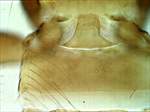Generic diagnosis
Small, yellow to light brown, macropterous Phlaeothripinae with prologation on antennal segment I. Head with genae weakly convex and narrowed to base, with one pair of small setae; eyes slightly larger dorsally than ventrally; postocular setae not reaching hind margin of eye; mouth cone short and acute; maxillary stylets retracted to eyes, almost touching medially in head, with narrow maxillary bridge. Antennae 8-segmented, segment I broad, inner margin with bifid tubercle extending beyond apex of segment II; III & IV each with 2 sense cones, IV & V with many small supernumerary sense cones ventrally. Pronotal major setae scarcely 3 times length of discal setae, am setae equal to discal setae; notopleural sutures complete. Prosternal basantra absent, ferna small and wide apart; chitinous islets of prosternum large; mesopresternum reduced to two very small lateral triangles; metathoracic sternopleural sutures long. Mesonotum with short posteromarginal cleft; metanotum weakly reticulate, median setae small. Fore tarsus with tooth in both sexes. Fore wing parallel-sided, with 2–6 duplicated cilia. Pelta with pair of large campaniform sensilla; tergites III–VII each with 2 widely spaced pairs of sigmoid wing-retaining setae, tergite II with only one pair; tergite IX setae slender, about as long as tube; tube much shorter than head, anal setae shorter than tube. Male sternite VIII without pore plate; tergite IX setae S2 shorter and stouter than setae S1.
Nomenclatural data
Crespithrips Mound & Morris, 2000: 132. Type species Crespithrips enigmaticus Mound & Morris 2000, by original designation.
Only two species are known in this genus.
Australian species
Crespithrips enigmaticus Mound & Morris, 2000: 133
Crespithrips hesperus Mound & Morris, 2000: 134
Relationship data
This Phlaeothripinae genus is considered related to two other genera of kleptoparasitic species on Australian Acacia trees, Xaniothrips and Vicinothrips.
Distribution data
The genus has been found widely across the semi-arid zone of central Australia.
Biological data
Both known species invade and breed within domiciles that are created by Sartrithrips species on the phyllodes of various Acacia tree species.
References
Crespi BJ, Morris DC & Mound LA (2004) Evolution of ecological and behavioural diversity: Australian Acacia thrips as model organisms. Australian Biological Resources Study & Australian National Insect Collection, CSIRO, Canberra, Australia, pp. 1–328.
Mound LA & Morris DC (2000) Inquilines or kleptoparasites? New phlaeothripine Thysanoptera (Insecta) associated with domicile-building thrips on Acacia trees. Australian Journal of Entomology 39: 130–137.




